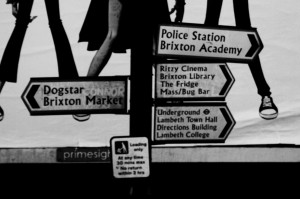Anne Briggs sent this story from her home in Auckland. She grew up in Brixton in the 1950s and started writing stories about her childhood for her grandchildren. She lived in Kings Avenue in a house which had once been the residence of the Governor of Brixton Prison.
For a time as children we lived at Clapham in South London (Clapham Park my Mother would correct me…) and we were regular visitors to Brixton market.
My Mother loved visiting markets no matter where we lived. Vegetables and flowers were our usual purchases but there were other occasional bargains of fabric, old books and more often than not some of Mum’s “finds”; vases, bits of china or sometimes items of silver cutlery which would be brought home, brought back to life and then become part of her collection.
We would meander beneath the arches of the colourful Brixton market in the fifties when the West Indian migration was just beginning. There were all manner of traders, hawkers, stalls selling anything – technicolour clothing which only the new residents of Brixton would wear, fruit piled up on shiny green fake grass cloths, vegetables of all kinds, and barrow boys with such constant and witty sales patter that people would gather round to listen to them and heckle them. There were the West Indian traders with their Caribbean vegetables and lilting speech encouraging passers by to try their vegetables and fruit. Then there were buskers, always with their promotors, either providing music or awe inspiring feats of physical flexibility, juggling or occasionally sword swallowers, all with their constant conversation attracting the crowed. Tanks of writhing eels in slightly murky water were alongside stalls shrouded in white selling the little pots of jellied eels – no doubt to emphasise their freshness….. Cockles, winkles and shrimps were measured in old half pint and pint tankards. Pills and potions offering miracle cures of some sort or another – if we hovered to try and read the packets we were whisked away!!
We were Mum’s army of porters loaded down with her purchases on such foraging expeditions. Sometimes a garden sieve for the garden, seedlings wrapped in newspaper, even on one occasion a pink and green flowered chamber pot with gilt edges which was put on a plant stand on the landing with a large aspidistra! Dad was not impressed.
On our way out of the market we always looked with fascination at the sweet man. The sweet man stood in front of a large stall, wrapped in sheets like the jellied eel folks, covered in piles of loose, unwrapped chocolates and sweets, all misshapen. The sheer abundance of these sugary treats was a sight to behold. A veritable myriad of colours and molten shapes. Pink and white coconut ice, chocolate in odd shaped blocks, jagged broken toffee, coloured boiled sweets, all glued together. Purchasers would make their choice and he would hammer them apart and put into tiny bags. In his white starched coat he would dissect these molten masses with great aplomb, scoop them up with a little brass shovel and then return to touting his wares. Part of the fascination was that the poor man had some sort of speech impediment which resulted in him sounding as if he had a mouth full of sweets. “Ssscchweets, Ssschweets, deelesssschuss sscchweets” ( “Sweets, sweets, delicious sweets, very cheap”) he would shout with resulting spray springing from his lips over the passers by and dabbing at the corners of his mouth with a large white handkerchief .
We would take turns guessing what he might have had in his cheeks and my young sisters would dissolve into giggles as I so cruelly mimicked him trudging home with our wares. “Sweets, sweets, delicious sweets cheap”.







